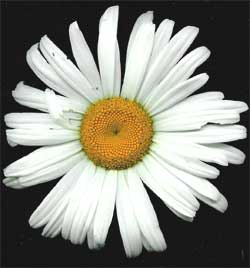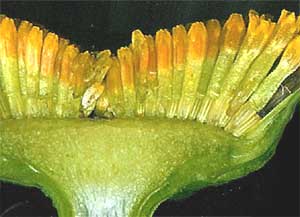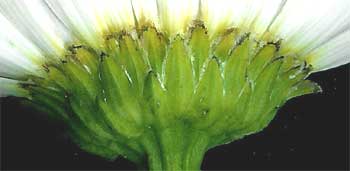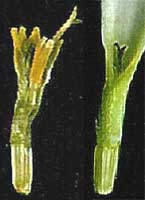
Mums, or Chrysanthemums, are classic composites -- they are "composite flowers." In other words, the mum blossom at the right is actually a collection of hundreds of flowers. In composite-flower terminology, each of the tiny "actual flowers" are called florets. Each tiny, orange bump in the center of the flowering structure at the right is the top of a disc floret, while each white "petal" is a ray floret. The flowering structure itself can be called a capitulum. Each of the many disk and ray floret at the right bears a regular blossom's male and female parts. Basic composite-flower structure is described on our Composite Flower Page.
When we speak of mums, usually we're referring to any species belonging to the genus Chrysanthemum, all native to East Asia and northeastern Europe. China is their "center of diversity." The traditional concept of the genus Chrysanthemum nowadays has been split into several genera. In 2021 the Flora of China recognizes 37 species, while mentioning that a Chinese account published in 1630 listed over 500 named cultivars.
If you make a cross-section of the above flowering head, you'll see what's shown below:


That picture shows how the crowded florets stand atop the platform-like green receptacle. At the right the arrangement is easier to see. In that picture, notice that at the base of each disc floret a future one-seeded fruit, known as a cypsela, is forming. Once the flowers are pollinated, the cypselae will enlarge and harden. When you buy "mum seeds" for sowing in your garden, you buy these cypselae.
As is typical of composite flowering heads, chrysanthemum flowering heads produce at their bottom a scaly, bowl-like involucre, as shown below.

In composite-flower terminology, the involucre's individual green bracts are known as phyllaries. In some composite species the phyllaries are very slender and in others very wide, and sometimes they are arranged in just one series so that they stand side-to-side instead of overlapping like those above. You can see that the Chrysanthemum's bracts are in three or more series and they overlap one another.

On our Composite Flower Page it's stated that many composite florets bear a pappus atop their cypsela, where the corolla also is attached. Pappuses come in many forms, and they're useful during identification. As the picture at the right shows, chrysanthemum florets bear no pappuses.
Similarly, in many kinds of composite flowering heads, each individual floret has beside it, or partly enveloping it, a papery scale known as a palea, or "chaff." Chrysanthemum flowering heads produce no paleae.